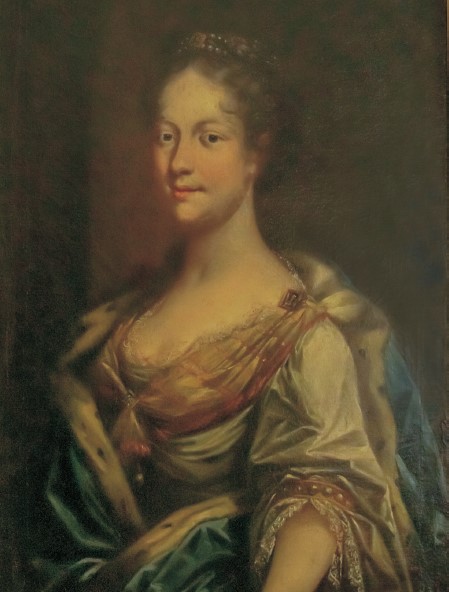Lubomirska Urszula, née Branicki
Lubomirska Urszula, née Branicki (1697-1776)
Parents: Katarzyna Scholastyka nee Sapieha (d. 1720) and Stefan Branicki (d. 1709)
Husband: Jan Kazimierz Lubomirski (d. 1737)
Lubomirska Urszula, née Branicki (1697-1776) was the sister of Jan Klemens Branicki, Elżbieta Tarłowa, née Branicki – wife to the voivode of Lublin, and Krystyna Sapieżyna, née Branicki. In 1724 she met Jan Kazimierz Lubomirski (d. 1737), who left the Military Order of Malta and married Urszula on November 11, 1725 in Białystok, in her brother’s palace. Their first child was born in Bolimów, which we know from a letter by a certain Tuszyńska – “Nothing peculiar going on here, the lord and lady are rarely in, the duke starost is in Bolimów and the Duchess herself is to give birth there” (pol. Tu u nas nic osobliwego nie słychać, Państwa bardzo mało, Książę starosta bolimowski jest w Bolimowie i sama Księżna Jej Mość, ma tam połóg swój odprawiać). This was, perhaps, the place of birth of the couple’s children – Franciszek and Anna, who died before reaching adulthood. Another child, a daughter named Maria, was born on August 8, 1730 and their son Antoni came into the world between 1731 and 1735. Lubomirska’s husband, Jan Kazimierz died unexpectedly between May and June 1737 and was buried at the Reformed Franciscan church in Rzeszów. Urszula never remarried. She maintained regular and lively contacts with her sister Elżbieta Tarłowa, née Branicki (died 1746) and her brother Jan Klemens Branicki, whom she often visited in Białystok. Leading a very intense social life, she was a source of information and gossip for her brother, as her daughter Maria would be a few years later. She spent the summer months of 1744 with her brother in Warsaw, participating in numerous pastimes and social gatherings. Together with her brother, she received King Augustus III in Białystok in place of her sister-in-law Barbara née Szembek, whom Branicki had divorced. This was a period of intense activity and mobility for the duchess, who visited friendly families – Tarło, Sapieha, Lubomirski (Joanna von Stein and Jerzy Ignacy). In 1749 she and her daughter Maria left for Prague and Teplice and only returned from their journey in 1752. During this stay, they met Empress Maria Theresa, from whom she received the Order of the Star Cross. In the late 1750s Urszula Lubomirska, with the help of her husband’s relative – Antoni Lubomirski – purchased the Starosty of Bratkowice, which bordered on her hereditary estates, and began to actively expand the estates’ economy. She opposed the election of Stanisław August and favoured the Bar Confederates. The last years of her life were filled with numerous property lawsuits. She died on May 6, 1776.
The Court:
After the purchase of the royal estate – the Bolimów starosty – the Lubomirskis lived in Bolimów and from 1727 in Głogów Małopolski, where they had a one-storey palace with an Italian garden. In the early 1730s they had a palace built in Rudna Mała – Rejterada, which served as their country residence. After the death of her husband, Urszula Lubomirska became the heiress of Głogów and all other goods. From 1770 she would enjoy spending a few months in Gdów near Wieliczka, which belonged to her.
See also:
R. Borkowski, Głogowska linia drzewa genealogicznego Lubomirskich [w:] Małe Miasta. Dom polski w refleksji badawczej, red. Mariusz Zemło, Białystok – Dynów – Supraśl 2021, s. 259-305
 Women's noble court in the Polish-Lithuanian Commonwealth in the Saxon times. Structure, people, culture, functions
Women's noble court in the Polish-Lithuanian Commonwealth in the Saxon times. Structure, people, culture, functions

